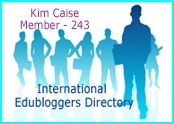 The past week I have come across different edubloggers talking about a fifth graders who writes a phenomenal blog. In a short amount of time the blog had received over 30,000 hits and is still growing today. Even though I have worked with fifth graders a number of years, I still find myself in awe and inspired by the outstanding work students do with and about technology. I find May of every school year to be bittersweet, as I am sure most educators do. The approach of summer and the end of another school year means helping fifth graders transition to middle school as sixth graders. We hand the students off to the middle schools and hope for the best. The author of the the “Twenty Five Days to Make a Difference” blog, Laura, I am sure will no doubt be successful in sixth grade and in any venture she undertakes.
The past week I have come across different edubloggers talking about a fifth graders who writes a phenomenal blog. In a short amount of time the blog had received over 30,000 hits and is still growing today. Even though I have worked with fifth graders a number of years, I still find myself in awe and inspired by the outstanding work students do with and about technology. I find May of every school year to be bittersweet, as I am sure most educators do. The approach of summer and the end of another school year means helping fifth graders transition to middle school as sixth graders. We hand the students off to the middle schools and hope for the best. The author of the the “Twenty Five Days to Make a Difference” blog, Laura, I am sure will no doubt be successful in sixth grade and in any venture she undertakes.
In her blog, she shares how why she created her blog and is dedicated to helping those in need:
In December of 2007, I decided that the best way to remember my grandpa during the holiday season would be by living my life like he did, by making a difference and being a leader. I decided to honor my grandfather’s memory by trying to make a difference every day for twenty five days. I wanted to be able to do little things, like kids my age typically do, instead of HUGE things that are sometimes hard for kids like me. I decided to write about my adventures here, and I also created a challenge.
I challenged everyone who read my blog to TRY to do something every single day during the holiday season to make a SMALL difference in his or her world. I explained that whoever made the “most difference” in December would win a $25.00 donation to the charity of his or her choice on Christmas night. I SAVED ALL OF MY ALLOWANCE ($25) FOR THE MONTH OF DECEMBER, AND I WAS REALLY SURPRISED AND EXCITED WHEN SEVERAL PEOPLE GENEROUSLY OFFERED TO MATCH MY DONATION (OR MORE)!
You can continue reading the post to see who matched her donation and learn about her monthly donation contest to the charity of the reader’s choice. She is doing extraordinary things for readers around the world that would not be possible without the use of this technology communication tool.
I am quite certain that her fifth grade teacher is filled with pride over her accomplishments. Probably more proud than the blogger’s parents! I know I would be knowing that I had that type of impact and made such a difference in a young person’s life. As an educator that is our ultimate reward, paychecks of the heart.
After you check out this fifth grader’s blog ask yourself, “Am I smarter than a fifth grader?” In some instances, the answer may be ‘No!’.








